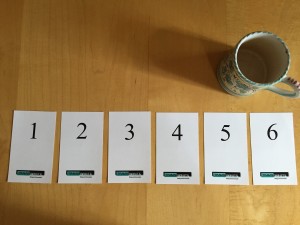Blockchain Beyond Bitcoin

Blockchain – It’s not just for Bitcoin anymore.
In 1979, Paper Mate introduced the world’s first ballpoint pen with erasable ink. Technology analysts considered it an important breakthrough and the news made headlines around the country. Many of us thought, “Wow! Finally I can write in ink and then erase it. How cool is that?” After a few moments of reflection, we had a second thought, “Why would I ever want to do that?”
Before erasable ink, we thought of ink’s permanence as a drawback and a disadvantage. After erasable ink appeared, we realized that ink’s permanence was actually its primary benefit. Write it once and you know it will never go away. If you might want to erase something, use a pencil.
In an odd way, permanence may also be the primary benefit of the blockchain technology that underlies Bitcoin. We think of databases as interactive, up-to-date records of the world as it is. The closer to real-time, the better. If you want to know what’s happening right this millisecond, high-speed databases will tell you.
But what if you want to know what happened some time ago? And what if you want assurances that the information you retrieve is tamper-proof and immutable? In other words, what if you want the electronic equivalent of permanent ink?
That’s exactly what blockchains on distributed ledgers give you. You can’t change the blockchain unless you can decrypt it – and that’s very difficult. Even if you can decrypt it on one network node, many original copies exist on other nodes. It’s fairly easy to restore the status quo ante. You can be very confident that the information you retrieve is unchanged from the original. It’s an immutable, permanent record.
The blockchain/ledger technology allows Bitcoin to keep a permanent record of all transactions. That’s important if you want to create a trusted financial system. But why stop at financial transactions? Are there other transactions that might benefit from permanent, tamper-proof records?
Indeed, there are. Here are a few that are in production or beta today:
- Ascribe – allows artists to “…lock in attribution [and] securely share and trace where your digital work spreads.”
- Storj – a potential weak point of cloud storage is that, ultimately, your data is assigned to one server. What if that server fails or is corrupted or hacked? To improve security and privacy, Storj breaks your data into blockchains and stores it on multiple servers.
- BitHealth – while Storj can store most any kind of data, BitHealth focuses on healthcare data. It claims to provide highly secure, uninterruptible, tamper-proof health data around the world.
- Everledger – where did your fancy diamond come from? How did it get here? Where is it insured? For how much? Everledger keeps a permanent, immutable “ledger for diamond certification and related transaction history.”
- Proof Of Existence or Bitproof — you want to prove that you had an idea at a certain date (preferably before anyone else). You could file a patent application. But that’s expensive, time-consuming, and public. Or you could register your document in the Proof of Existence or Bitproof blockchain databases.
- Warranteer – you buy a product that comes with a warranty, which is described in a document. The product goes bad at approximately the same time that the document goes missing. Why not save the warranty in Warranteer’s blockchain, cloud-based database?
I could go on and on. (If you want to dig deeper, click here, here, and here). While Bitcoin popularized the technology, blockchain extends far beyond the financial world. Indeed blockchain may disintermediate and disrupt supply chains around the world. If so, the world will get much more efficient. Is that what we want?
New York, The NORC

Share my NORC with me.
A lot of our friends are downsizing. The kids have moved out, they don’t need the big house anymore, and they’d rather live in a smaller place and free up some of their funds for travel … or maybe for the grandkids.
Some of our friends are moving into naturally occurring retirement communities or NORCs. These communities were not designed for older people but, over time, have evolved into place where seniors like to congregate.
One of the communities is not far from us. It’s one of the first gated communities in Denver (and still one of the very few). Designed in the 70s, it consists mainly of semi-detached, single story homes. It’s close to a main street but not on it. There’s very little traffic. It’s also a level area, so it’s easy to walk around. There’s a small community center, with a pool. Maintenance workers will help you maintain your place.
The development wasn’t designed as a retirement community. But all the features and amenities make it congenial to older people. There’s also a network effect. As older people move in, they attract other older people (and, perhaps, make it less attractive to younger people).
Some cities have become NORCs in their own right. Tucson and Phoenix come to mind in the west. Miami probably serves a similar function in the east. A number of our friends have homes in Tucson. Some live there year round; others just escape cold northern winters for six months or so. When we visit our friends, we mainly see an older demographic.
Michael Hunt, a professor at the University of Wisconsin, coined the term NORC back in the 80s. According to Wikipedia, there are now three types of NORCS:
- Classic NORC – mainly this is a building, or cluster of buildings, filled mainly with older residents. By and large, they’ve aged in place. Also known as a vertical NORC.
- Neighborhood NORC – known as a horizontal NORC, this is a small community of single and multi-family homes.
- Rural NORC – a rural community, perhaps where the kids have left and older people tend to congregate.
Most of our friends who live in NORCs live in the second type – neighborhoods and gated communities whose amenities — and/or weather — appeal to older people. The gated community near us is definitely a Type 2 NORC.
However, I would argue New York City — which is more of a Type 1 NORC — is the best NORCtown in America. For one thing, you don’t need to drive. For older people who can no longer drive (or no longer want to), New York is a natural. Then there’s the food. Don’t want to cook anymore? No need to go to the retirement home’s dining hall (where the food is typically awful). You can get almost any food you want delivered to your door.
We might think of New York as a vertical NORC but there’s also a horizontal dimension. Most apartments are on one level – there are no stairs to negotiate. Plus, you have the doormen and supervisors to help you with everything from simple chores to complex maintenance work.
If you want to get a dog to keep you company, you can hire a dog walker to keep it properly exercised. Medical care is widely available and easy to get to. Some docs will even come to your home. And, of course, there’s plenty to do. Everything from Broadway plays to great people watching. Don’t worry – you won’t get bored.
Why isn’t the Big Apple known as the world’s largest NORC? Probably a lack of marketing. But just wait. It won’t belong before Frank Sinatra’s classic voice is remixed to sing New York, The NORC.
Creating A Design Culture

Let us design your business.
I hate to admit it, but I may have spent my years in the software business looking through the wrong end of the telescope. I worked for sophisticated technology companies. Quite often, the fundamental question that animated us was, “What more can we do with all this great technology?”
As today’s technology companies (even IBM) are discovering, good design starts at the opposite end of the telescope: with user needs. Indeed, we may even need to discover user needs that users aren’t aware of. The trend is generally lumped under the terms, design thinking or design-oriented culture.
So how does one create a design-oriented culture? Here are some thoughts I’ve culled from recent readings.
It’s about the experience – the central question is simple: what do customers really need? Too often however, we add a limiting clause to the question: what do customers really need from us? Rather than focusing on the complete user experience, we ask a more self-centered question: How can we get customers to want more of what we have to offer?
Design thinking broadens the frame. Rather than thinking only about what we have to offer, we might think about how users acquire the product, how they learn to use it, and what ancillary products they might need to make the product useful.
McKinsey offers up two examples: 1) HP doesn’t just wait for you to order new ink cartridges. They monitor your use and send you cartridges before you even know you need them. 2) John Deere doesn’t just sell tractors anymore. They also offer,”… digital services such as crop advisories, weather alerts, planting prescriptions, and seeding-population advice.”
It’s about making sense – Jon Kolko in Harvard Business Review, argues that technologies and systems (think of our healthcare system) are so complicated today that people just can’t make sense of them. Good designs should address this. I find, for instance, that Turbo Tax addresses a complex issue and, in Kolko’s terminology, makes it “simple, intuitive, and pleasurable.” In other words, it’s well designed. Imagine if we could make buying health insurance equally simple, intuitive, and pleasurable.
It’s about prototypes – I remember introducing new products with a “big reveal”. We developed the products in secret. We couldn’t talk to customers about them – that would be selling futures. We built some buzz and, when everything was ready, we popped the new product out of the box. Sometimes the big reveal worked great. Sometimes not.
Kolko argues that design-cultures are much more interested in prototyping their ideas all along the development path. Kolko writes that, “The habit of publicly displaying rough prototypes hints at an open-minded culture, one that values exploration and experimentation over rule following.”
It’s about emotions – software seems like the ultimately rational product. Buying software should be rational as well – the product with the most features should always win.
Alas, it’s just not true. Indeed, the software industry has much more in common with the fashion industry than one might imagine. It’s not just what the software does. It’s how it makes you feel as it’s doing it. If it does the job but makes you feel stupid, it’s not well designed.
(As an aside, I think this is why the Lars Lawson cartoon character worked well for Lawson Software. Lars touched on our emotions – something quite unusual for B2B software).
It’s about thinking – as Lawton Ursrey notes in Forbes: “Design thinking combines creative and critical thinking that allows information and ideas to be organized, decisions to be made, situations to be improved, and knowledge to be gained.”
At the simplest level, design thinking means doing an about-face. Rather than facing inward, we turn around and face outward. We send our employees outside and bring our customers inside. It’s about attitude more than anything else. Unfortunately, attitudes are very hard to redesign.
Are Creative Countries Happier? More Competitive?

Good place to be creative.
Is it possible to measure a country’s creativity? If so, how does creativity relate to other national characteristics like prosperity, sustainable growth, and happiness?
And, is it time to think less about creative companies and more about creative cities? Perhaps instead of giving tax breaks to attract companies, creative cities should charge a fee to companies that want to capitalize on their creative citizens. But then, how do you create a creative city?
Creativity is joining the traditional trio of land, labor, and capital as one of the key drivers of productivity and growth. In the traditional industrial world, we could use standard measures of land, labor, and capital to identify competitive advantages and disadvantages. But what about creativity? How do we measure countries (and cities) on their creative potential? And how do we develop a competitive advantage in creativity?
These are some of the basic questions the 2015 edition of the Global Creativity Index (GCI). The Martin Prosperity Institute* (MPI) created the index and first published it in 2004, with an expanded version arriving in 2011. (Click here). This year’s index, published over the summer, is the most comprehensive yet.
Can you really measure a country’s or a city’s creativity? MPI argues that there are three elements of creativity and that we already have multiple indexes for each of them. Conveniently, each element begins with a T.
Technology – countries that produce innovative technologies are probably more creative than those that don’t. The GCI uses existing indexes of R&D investment and patent activity to measure the Technology component of creativity.
Talent — the war for talent is certainly raging in creative circles. Old school companies – like Accenture – are buying up design firms – like Fjord – to focus their creative talents on business issues. But how do you measure the creative talent in a country? The GCI uses educational and occupational indexes to identify the creative class.
Tolerance – we know that diversity counts in innovation. Getting different people with different ideas to “collide” is a fundamental innovation strategy. Diversity requires tolerance of other people and of ideas that were not invented here. How to measure tolerance? The GCI uses two proxies: “openness to ethnic and religious minorities and openness to gay and lesbian people”.
MPI researchers create an index for each of the three Ts and then roll them altogether to create one Global Creativity Index. In this year’s ranking, Australia comes in first – it’s the most creative country in the world. Following Australia (in order) are the USA, New Zealand, Canada, Denmark, Finland, Sweden, Iceland, Singapore, the Netherlands.
Does this list sound familiar? It’s quite similar to the list of the happiest countries in the world. (Click here and here). The Nordic countries dominate the happiness rankings. Similarly, Australia, New Zealand, Canada, and the Netherlands are always near the top of happiness indexes.
So, does happiness cause creativity or vice-versa? Are we just measuring the same thing in different ways? Let’s talk about it more in upcoming articles. In the meantime, I hope that you’re both happy and creative.
*MPI is headed by Roger Martin and located at the Rotman School of Management at the University of Toronto. Long-time readers of this website will remember that I’ve written about both Martin and Rotman several times. Martin encouraged Rotman to adopt design thinking as a core element of the curriculum. I’ve also referenced Martin’s efforts to bring critical thinking to business schools. He also advised A.G. Lafley of P&G on strategy. Interesting thinker; interesting school.
Equal Opportunity Idea Generation

Pick a card.
At the beginning of each term, I give my critical thinking students a set of six cards. Each card has a number on it – one through six. (I also add my logo to do a little low-cost branding).
Students bring the cards to each class. I use them to guide discussions about topics where there is no obvious right answer. I ask a question with up to six alternative answers. I then ask the students to select the “best” answers and — when I give a signal – to hold up the number that represents their choice.
The trick is to do it simultaneously. Then I say something like, “Jamal, you’re holding up number six and Carmen is holding up number three. Let’s discuss why you’ve chosen different answers.” This often leads to some very robust discussions. Nobody hides and everyone knows that they may be asked to explain their opinion. If you mix in a little humor, it can also be a lot of fun.
I call these equal opportunity discussions. In most discussions, I find that whoever speaks first exerts undue influence on every subsequent speaker. It’s a phenomenon called social convergence and it’s impossible to eliminate unless you have everyone “speak” simultaneously. With simultaneous responses, everyone has an equal opportunity to get their idea across.
I first used this system during the merger of Lawson, an American software company, and Intentia, a Swedish software company. Both companies had about 2,000 employees. They also had different national traditions and corporate cultures. Every employee had an opinion about what the new company culture should be. The question for managers (including me) was: how do we gather, weigh, and merge these opinions?
We decided to use equal opportunity discussions focused on how the new culture would respond to different behaviors. For instance, in a meeting with up to a dozen employees, we might ask a simple question: “Klaus is always late to staff meetings. In our new company culture, what do you think Klaus’ manager should do?” We included a list of up to six answers. We asked the employees to consider the answers and then hold up her or his chosen answer simultaneously. This produced some very spirited discussions.
We kept track of how different groups answered each question. Did marketers answer the questions differently than, say, engineers? How about executives versus individual contributors? It took time but it was very valuable information that ultimately led to a coherent new culture.
A similar technique works well in promoting innovation. The first step is to gather a wide range of diverse ideas. Letting one person speak first (especially the boss) will reduce diversity. When I ran staff meetings focused on creating new ideas, I would frame up the issues several days in advance. I asked each participant to consider the issue and develop his or her best ideas. I then asked them to write down their ideas – no more than a paragraph or two. When we got to the meeting, I asked everyone to push their written descriptions to the middle of the table. I then gathered them up, shuffled them a bit, and started the discussion.
I thought about these processes when I spotted a recent article in Harvard Business Review titled, “People Offer Better Ideas When They Can’t See What Others Suggest.” The context is slightly different – the authors are looking at programs like Dell’s Idea Storm site or the My Starbucks Idea site.
Though the context is different, the process is essentially the same. The authors write that, “The trick is to avoid clustering, where the same people have the same experiences.” They also created anti-clustering software that ensures “…that no participants share the same body of ideas and the same neighbors as anyone else.”
I’m sure the anti-clustering software is more sophisticated than my cards. But if you want to get off to a quick start, the cards work pretty well. Just make sure that every idea has an equal opportunity to “win”.